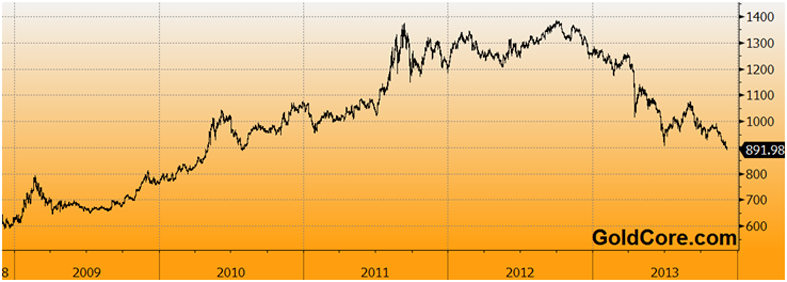Today’s AM fix was USD 1,213.00, EUR 892.57 and GBP 741.13 per ounce.
Yesterday’s AM fix was USD 1,219.00, EUR 898.50 and GBP 743.07 per ounce.
Gold rose $3.70 or 0.3% yesterday, closing at $1,222.70/oz. Silver slipped $0.03 or 0.16% closing at $19.12/oz. Platinum climbed $14.50, or 1.1%, to $1,352.25/oz and palladium rose $3, or 0.4%, to $711.97/oz.
Gold in euros fell to 892.16 euros/oz, the lowest since August 3, 2010. Gold in euros has fallen 30% this year, against 28% for gold in dollar terms. Gold fell to 740.64 pounds/oz, the lowest since August 3, 2010. Gold has fallen 28% in sterling terms this year.
Gold is higher in Aussie dollars this morning, due to weak Q3 GDP growth and concerns about the Australian economy.

Gold fell to the lowest in almost five months in London this morning as very tentative signs of improving U.S. economic growth added to continuing speculation that the Federal Reserve may reduce its massive $85 billion per month bond buying programme.
U.S. manufacturing accelerated at the fastest pace in more than two years in November, data showed on December 2. Less positive data showing consumer sales on Black Friday were worse than expected was ignored.
Gold is set for the first annual drop in 13 years as trend following traders and more speculative investors lose faith in the metal as a trade. Store of value and financial insurance bullion buyers remain steadfast and continue to buy physical on the dip – especially in Asia and of course China.

Cross Currency Table – (Bloomberg)
It is interesting to note that the hedge fund Tiberius, who have been highly vocal as bearish on gold for years have changed their long term position. They remain bearish in the short term but believe that weak hands have been washed out of the market. They believe that strong hands will propel prices higher again – possibly later in 2014.

Gold in Pounds, 5 Year – (Bloomberg)
Minutes of the Fed’s October meeting released November 20 showed that policy makers expected an improving economy to warrant trimming debt purchases in coming months. The Fed next gathers on December 17-18.
Reducing the huge bond buying programme has been suggested for some years now. As ever, ignore the jawboning – watch what they do, rather than what they say.

Gold in Euros, 5 Years – (Bloomberg)
Era Of Bond Holder Bailouts Ending – That Of Depositor Bail-In Cometh (Part 1)
The era of bondholder bailouts is ending and that of depositor bail-in is coming.
The changing financial landscape post crisis poses challenges to savers and investors globally. It is important we consider how savings and investments can be protected.
Bail-ins are a risk in the coming years and yet there is a lack of appreciation of this risk as there was a lack of appreciation of the risks posed by property bubbles and the global debt crisis.
This research note is therefore timely and welcome as there is a lack of research regarding a bailin and bail-ins and the ramifications thereof.
It will take a number of years for the final configuration of the new financial order to become clear. This means that there are difficulties inherent in selecting appropriate investments when the ultimate outcome is unclear. Apart from that, what we do know at present is that there are straws in the wind that should concern savers.
The approach taken with failing banks in Europe, to in one form or another socialise the debts across taxpayers created a so called doom loop. As the banks got weaker more and more of their debts were passed to already strained sovereign treasuries, weakening them and making it more difficult for them to intervene early in stressed banks. The realisation that, with banks which were multiples in size of the sovereign regulating them, this could not go on was slow to emerge but it has now done so.
In an as yet to be determined but medium term future, banks which face losses will have to act in an avowedly capitalistic manner. First reserves and equity, then senior, then junior debt will be used as the risk capital in order to fill these debt holes. What is new is that if losses continue, after burning through this capital, rather than the state, it is depositors who will be in play.
Beyond that we see other threats to the stability and profitability of the banking system. The EU has launched a consultative process on the sustainability of the present financial system and has concluded in early work that a much more hybrid system, merging the bank based continental system and the Anglo Saxon market scheme, is needed.
Combined with the inevitability of inflation (even the desirability of same in so far as it entails in its early stages a recovered economy), these suggest that savers will face a complex and perhaps lower return environment in the medium term.
In that context a move to increased allocation of savings to alternative investments, including a prudent allocation of some 5% to 10% to precious metals, is a sensible policy.
This research note is very useful in pulling together some of these strands and others and should be required reading for savers internationally and for medium and long term investors.

*Dr Brian Lucey is Professor of Finance at the School of Business at Trinity College Dublin. He studied at graduate level in Canada, Ireland and Scotland, and holds a PhD from the University of Stirling. His research interests include international asset market integration and contagion; financial market efficiency, particularly as measured by calendar anomalies and the psychology of economics.
His research on gold has established that gold is important as a long term diversification due to gold’s “unique properties as simultaneously a hedge instrument and a safe haven.”
Download our Bail-In Guide: Protecting your Savings In The Coming Bail-In Era(11 pages)
Download our Bail-In Research: From Bail-Outs to Bail-Ins: Risks and Ramifications (51 pages)







via Zero Hedge http://feedproxy.google.com/~r/zerohedge/feed/~3/nNVI2oZ2Q0Y/story01.htm GoldCore



![]()

























 greatest utility from this irrelevant service is that it is now social-media friendly and provides a ready to go infographic:
greatest utility from this irrelevant service is that it is now social-media friendly and provides a ready to go infographic: